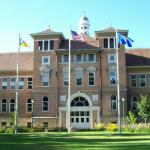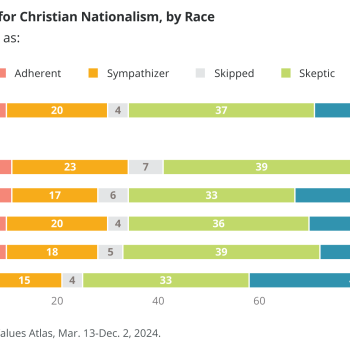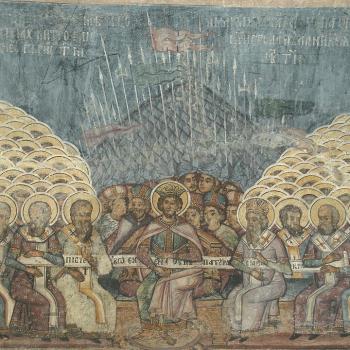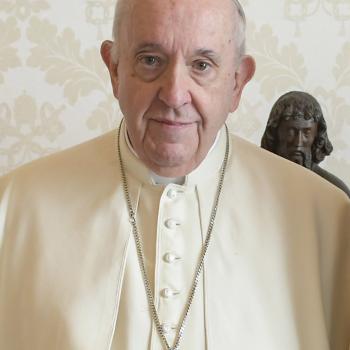A Wrinkle in Time is a Cold War artifact. The specter of IT, a giant disembodied brain on the dystopian planet of Camazotz, pervades the pages. IT oppresses the universe and brainwashes people to follow its authority as mindless robots. Children on Camazotz dribble basketballs in the same rhythm. It is nearly impossible not to interpret IT as a totalitarian Marxism that threatens the world’s liberty. It’s described as an overwhelming darkness set against the light and beauty of the free world. As the adventurers enter IT’s headquarters, one of them notes, “I think we ought to have passports or something. This is much more than leaving America to go to Europe.” Indeed, it’s like they’re entering KGB headquarters in Moscow.
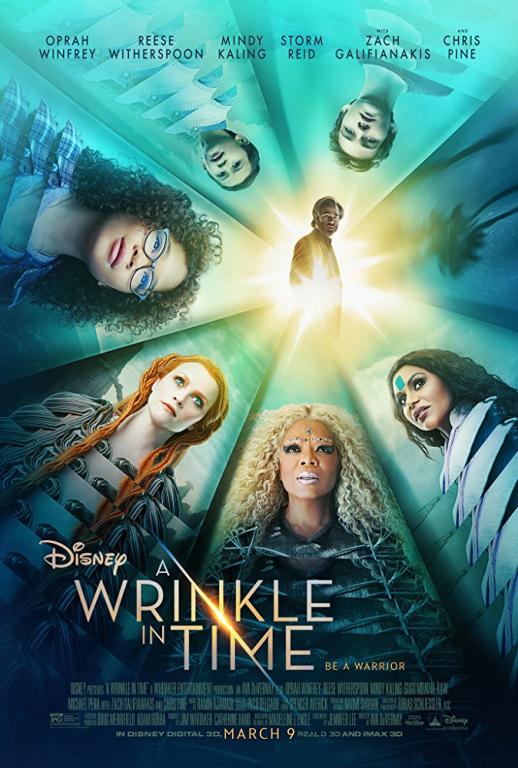 Over the past month, I’ve been reading A Wrinkle in Time (1962) to my children—five pages every night at bedtime. As I experience this classic for the first time as an adult, I have been struck at just how prominently the Cold War looms over the text. As IT indoctrinates the masses, the protagonists recite the Declaration of Independence: “all men are created equal, that they are endowed by their creator with unalienable rights.” When a boy under the spell of IT contends that “in Camazotz all are equal. In Camazotz everybody is the same as everybody else,” the young heroine incants anticommunist slogans such as “Like and equal are two entirely different things.”
Over the past month, I’ve been reading A Wrinkle in Time (1962) to my children—five pages every night at bedtime. As I experience this classic for the first time as an adult, I have been struck at just how prominently the Cold War looms over the text. As IT indoctrinates the masses, the protagonists recite the Declaration of Independence: “all men are created equal, that they are endowed by their creator with unalienable rights.” When a boy under the spell of IT contends that “in Camazotz all are equal. In Camazotz everybody is the same as everybody else,” the young heroine incants anticommunist slogans such as “Like and equal are two entirely different things.”
If L’Engle’s portrayal of communism as the evil “other” was not unusual, her antidote certainly was. While many Cold Warriors—both conservative and liberal—practiced a hawkish resistance, the author of Wrinkle offers a third way of creative and redemptive resistance from the margins. She crafts a story in which a desperate fight against evil is left completely in the hands of resisters who work outside the halls of power and without the aid of violence. The cast of characters includes a band of children led by Meg, an awkward, “outrageously plain” adolescent girl insecure about her intelligence and braces and glasses. They are guided by three social outcasts named Mrs. Whatsit (portrayed in the book as an eccentric “tramp”), Mrs. Who, and Mrs. Which. As this ragtag group searches for their father, navigating the universe by tessering from one place to another, Meg feels ill-equipped to make decisions and to rescue her father and brother from the grip of a dark, cold, ominous shadow of evil.
It is a frightening narrative, especially when the kind and adorable little boy Charles Wallace loses his very identity. Having initially resisted IT, declaring that “we will make our own decisions, thank you,” Charles Wallace is soon transfixed by the power and allure of IT. He speaks in a canned, flattened, two-dimensional voice that betrays his loss of identity and agency. His eyes become cold and strange. When provoked, he becomes a snarling little demon that turns on his beloved sister and father.
As the narrative climaxes, Meg wrestles with her response to evil. Her first instinct is to use a dissecting knife to “slash at IT, cutting ruthlessly through cerebrum, cerebellum.” Embodying a “sick rage,” she strikes out at Charles Wallace, attacking him so forecefully that he falls “sprawling, hitting his head a with a sharp crack against the marble floor.” Charles Wallace’s eye-for-an-eye response is to punch her hard in the stomach with his fist. She discovers that violence doesn’t end violence. As Gandhi said, “An eye for an eye makes the whole world blind.”
Indeed, violence begets violence. Meg asks herself, “If that great brain were cut, were crushed, would every mind under ITs control on Camazotz die too?” She realizes that everyone holds the “possibility of salvation”–and the possibility of damnation. In fact, Meg begins to lose her own soul. “It was loathing,” L’Engle narrates. “It was hatred, sheer and unadulterated, and as she became lost in hatred, she also began to be lost in IT.”
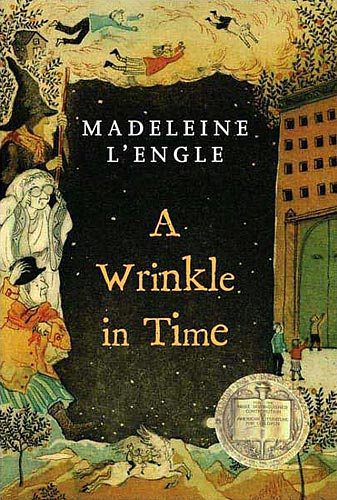 As Meg is forced to a point of decision, she remembers Mrs. Whatsit, who modeled a third way that transcended passivity and violence. Meg realizes, “Love. That was what she had that IT did not have.” Perhaps offering love could cause her enemy’s hatred to “shrivel up and die.” Indeed, in the final pages of Wrinkle, she challenges Charles Wallace with love. “I love you. Charles Wallace, you are my darling and my dear and the light of my life and the treasure of my heart. I love you. I love you. I love you.” And it works. His eyes stop their twirling. The tic in his forehead stops its revolting twitch. And as the icy coldness leaves their presence, his little arms clasp tightly around her neck.
As Meg is forced to a point of decision, she remembers Mrs. Whatsit, who modeled a third way that transcended passivity and violence. Meg realizes, “Love. That was what she had that IT did not have.” Perhaps offering love could cause her enemy’s hatred to “shrivel up and die.” Indeed, in the final pages of Wrinkle, she challenges Charles Wallace with love. “I love you. Charles Wallace, you are my darling and my dear and the light of my life and the treasure of my heart. I love you. I love you. I love you.” And it works. His eyes stop their twirling. The tic in his forehead stops its revolting twitch. And as the icy coldness leaves their presence, his little arms clasp tightly around her neck.
“Meg, you saved me! Meg, you saved me!” Her real power rests in her ability to love Charles Wallace, even as he has become her enemy.
This is not the typical white evangelical narrative, which usually consists of showy alliances with military and political leaders and a gospel of redemptive violence—often with a dash of toxic masculinity. Billy Graham, whose emergence coincided with the first frightening years of anxiety over Soviet aggression, kept the toxic out of his masculinity, but he did lift a soaring evangelical anticommunism to new heights. According to biographer Steven Miller, he “linked his evangelism to the destiny of the United States and its leaders.” At a 1947 “Christ for This Crisis” crusade in Charlotte, North Carolina, Graham preached the following sermons: “The End of the World” and “Will God Spare America?” He declared that communism was “Satan’s religion,” a “great anti-Christian movement.” In 1952 Graham mailed the book Communism and Christ to every member of Congress and the presidential cabinet. Communism, the book suggested, had its very own trinity: “Marx the Lawgiver, Lenin the Incarnate Truth, Stalin the Guide and Comforter.”
L’Engle wrote in an era when evangelical hawks practiced a politics of power and fear. If possible, the politics has gotten even crasser (though Graham himself softened considerably in the 1980s), which makes the insights of A Wrinkle in Time all the more striking. The book continues to point to a third way of creative resistance to evil. It’s a third way that should not feel as new as it does. That’s because there are myriad examples in history: the “turning the other cheek” of Jesus (as described in the Sermon on the Mount), the radical hospitality of the Early Church (as narrated by Rodney Stark in The Rise of Christianity), the nonviolent activism of the black church (as narrated by David Chappell in A Stone of Hope), and Coptic Christian protection of Muslims in Cairo.
Creative acts of love flip the script, interrupting patterns of violence and conflict. In nearly all of these cases, it is not persons wielding traditional power and political standing that innovate ways of peace. Indeed, Miguel de la Torre calls Christians to begin at the margins, to privilege the invisible and disempowered. Perhaps it is precisely because of their experiences on the margins that racial minorities, women, and the impoverished are better equipped to understand and address social problems.
As white religion diminishes, Christians of color are poised to lead toward more redemptive and constructive solutions. Majority World Christianity is far outpacing Western Christianity, and Christian immigrants to the United States are revitalizing the American church. L’Engle could not have imagined the United States becoming a majority-minority nation in 2044. But all the way back in 1961, she cast marginalized persons as creative practitioners of redemption. (In the just-released film version, director Ava DuVernay extends the upside-down script with a spectacularly diverse cast.)
I imagine the coming religious transformation looking a lot like Mrs. Whatsit. She enters the narrative wearing bundles of tattered clothes, a rough overcoat, and black rubber boots. She appears as a streetperson to the protagonists. But before their eyes, she “shimmers, quivers, shifts” and transforms into “a creature more beautiful than any Meg had ever imagined.” L’Engle writes, “From the shoulders slowly a pair of wings unfolded, wings made of rainbows, of light upon water, of poetry.” The newly strong, but still delicate, Mrs. Whatsit invites them to come “onto my back now.”
As Christian America blessedly ends, those used to operating out of a position of privilege must courageously lay aside power and place it in the hands of others whose hard experiences on the margins have given them beautiful tools to innovate third-way solutions.
It’s even possible that white men could follow in their wake. As Calvin, Meg’s handsome, blue-eyed companion, joyfully exclaims to her, “Lead on! I’ve never even seen your house, and I have the funniest feeling that for the first time in my life I’m going home!” By following her lead, he is finding a more authentic version of himself—not unlike white evangelicals who, if they have the eyes to see, can find the roots of their faith in the ancient Near East among a marginalized people suffering in the backwaters of the Roman Empire.
If L’Engle’s narrative is true, this is a possible future. In one of the climactic scenes of the just-released film, Meg sees the way forward in the midst of danger. She cries out to Calvin, “Do you trust me?” The audience watches Calvin deliberate about whether to give up his own agency, something that is terribly hard for handsome, blue-eyed men to do. He finally says, “I trust you,” and sprints to follow her lead.


